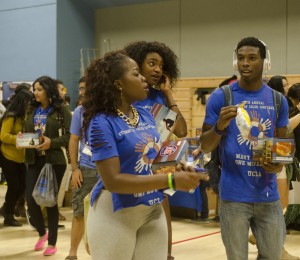Three protesters stood on the roof of a white Chevy in the intersection of Wilshire and Westwood boulevards, one wielding a megaphone, to voice their discontent with what they think is a low level of diversity in higher education.
“Don’t forget why you’re here. We’re here for change,” said University of California student regent Cinthia Flores to hundreds of students at the protest. “Keep on working. Keep on working.”
The demonstration in Westwood Village was the marquee event of this past weekend’s 25th annual Student of Color Conference.
More than 1,200 college and high school students came to the UCLA campus to be a part of the event, during which minority students and their allies addressed issues of inequality.
The annual event was put on by the University of California Student Association, a coalition of students that advocate on behalf of UC students.
Throughout the weekend, students participated in workshops on topics such as race, gender, poverty and worldwide injustices. Saturday’s events included a presentation that argued why UC President Janet Napolitano should not be in office, as well as the protest demanding more racial diversity in higher education.
Many of the students at the conference said they supported a UCSA campaign called Invest in Graduation, Not Incarceration; Transform Education, or IGNITE. The campaign calls for state leaders and the UC to invest more funding and resources i education rather than in prisons.
For some attendees, the conference was a new experience and an opportunity to meet other people who share common backgrounds and struggles. For others who had attended the conference multiple times, it was a final farewell.
Eric Adams, a fourth-year Afro-American studies student and the lead organizer of workshops and caucuses for the event, attended his third and final conference as a student this year.
Adams described his first experience at the 2011 conference as eye-opening. He said he liked meeting other black queer students like himself, since he does not see them very often in the UC.
“(The conference) has made me understand that I have to do this for future students,” Adams said. “They need the opportunity to have that conversation (about race, sex and gender).”

“This is our school system. The UC is for us, (the students),” Daniel said. “It’s good that we could talk about what’s wrong (with our schools) without beating around the bush.”
A series of workshops, a main part of the conference, allowed participants to discuss how they are personally affected by issues of diversity and what they think are larger institutional problems hindering diversity.
Conference participants criticized what they called the “school-to-prison pipeline,” a term describing the movement of students from minority racial backgrounds from schools into the criminal justice system. They said that increased punishment for students from minority racial backgrounds leads to increased incarcerations. It was also a main reason for the protest in Westwood Saturday afternoon.
“If a student has a challenge, they need support, not punishment,” said Matt Haney, a commissioner on the San Francisco Unified School District Board of Education and a lecturer and education fellow at the Institute of Design at Stanford who spoke at the conference. “We need a paradigm shift.”
The conference also addressed what students called international injustices.
A workshop on the Turkish government’s denial of the Armenian Genocide of 1915 was led by William Bairamian, a former executive for the Armenian National Committee of America, a Washington, D.C., based lobbying group.
Sophia Armen, a former student body president of UC Santa Barbara who is of Armenian decent, said she believes the Armenian Genocide is a relevant issue because she thinks they also have had their histories and struggles covered up.
“As youth we need to come together and talk about our histories, especially people who have watched their histories be systematically erased,” Armen said.
The conference helps students from minority racial backgrounds work together to address challenges that they may have in common, said Morris Sarafian, a second-year political science student who participated in the conference.
“This is my first conference, and to see this many people, this many students, unified on a single cause is extremely inspiring and it gives me hope that we can actually better ourselves,” Sarafian said.
Contributing reports by Jasmine Aquino, Bruin contributor.
